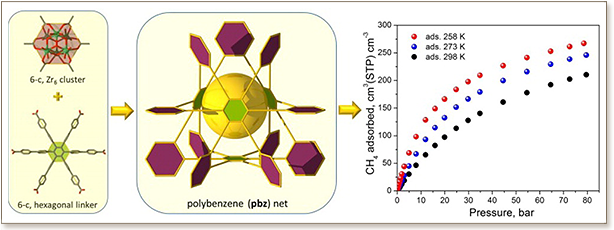

 The ability to direct the assembly of hexagonal building units offers great prospective to construct the awaited and looked-for hypothetical polybenzene (pbz) or “cubic graphite” structure, described 70 years ago. Here, we demonstrate the successful use of reticular chemistry as an appropriate strategy for the design and deliberate construction of a zirconium-based metal–organic framework (MOF) with the intricate pbz underlying net topology. The judicious selection of the perquisite hexagonal building units, six connected organic and inorganic building blocks, allowed the formation of the pbz-MOF-1, the first example of a Zr(IV)-based MOF with pbz topology. Prominently, pbz-MOF-1 is highly porous, with associated pore size and pore volume of 13 Å and 0.99 cm3 g–1, respectively, and offers high gravimetric and volumetric methane storage capacities (0.23 g g–1 and 210.4 cm3 (STP) cm–3 at 80 bar). Notably, the pbz-MOF-1 pore system permits the attainment of one of the highest CH4 adsorbed phase density enhancements at high pressures (0.15 and 0.21 g cm–3 at 35 and 65 bar, respectively) as compared to benchmark microporous MOFs.
The ability to direct the assembly of hexagonal building units offers great prospective to construct the awaited and looked-for hypothetical polybenzene (pbz) or “cubic graphite” structure, described 70 years ago. Here, we demonstrate the successful use of reticular chemistry as an appropriate strategy for the design and deliberate construction of a zirconium-based metal–organic framework (MOF) with the intricate pbz underlying net topology. The judicious selection of the perquisite hexagonal building units, six connected organic and inorganic building blocks, allowed the formation of the pbz-MOF-1, the first example of a Zr(IV)-based MOF with pbz topology. Prominently, pbz-MOF-1 is highly porous, with associated pore size and pore volume of 13 Å and 0.99 cm3 g–1, respectively, and offers high gravimetric and volumetric methane storage capacities (0.23 g g–1 and 210.4 cm3 (STP) cm–3 at 80 bar). Notably, the pbz-MOF-1 pore system permits the attainment of one of the highest CH4 adsorbed phase density enhancements at high pressures (0.15 and 0.21 g cm–3 at 35 and 65 bar, respectively) as compared to benchmark microporous MOFs.